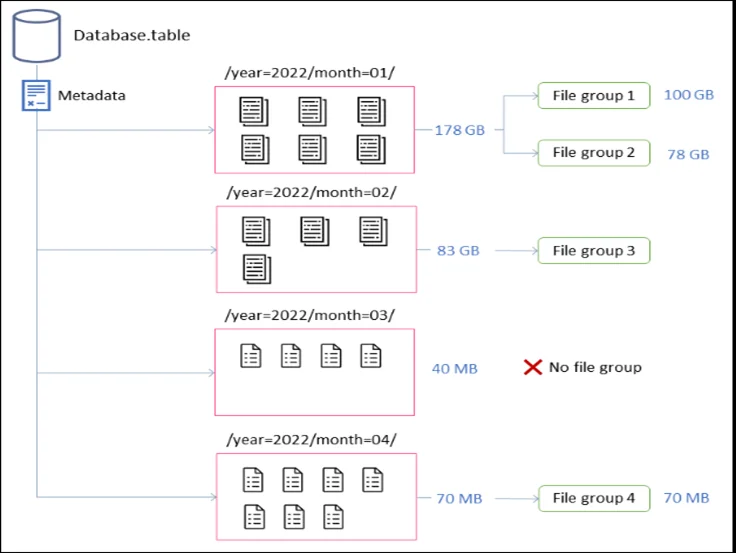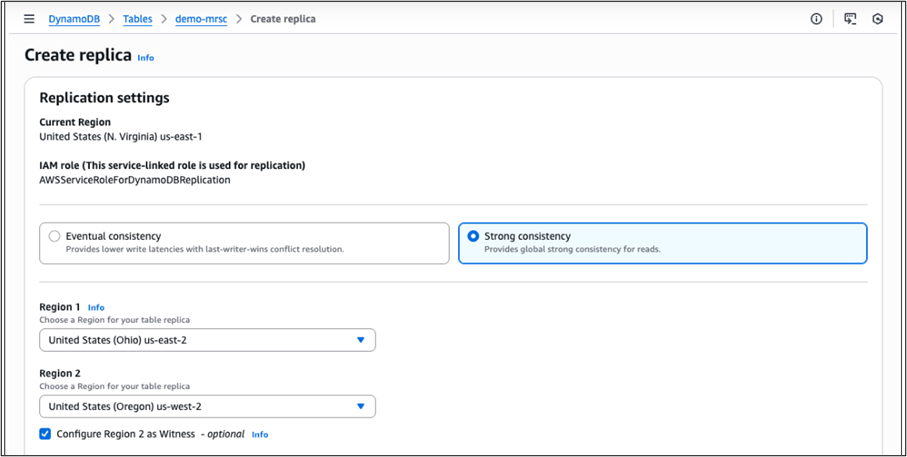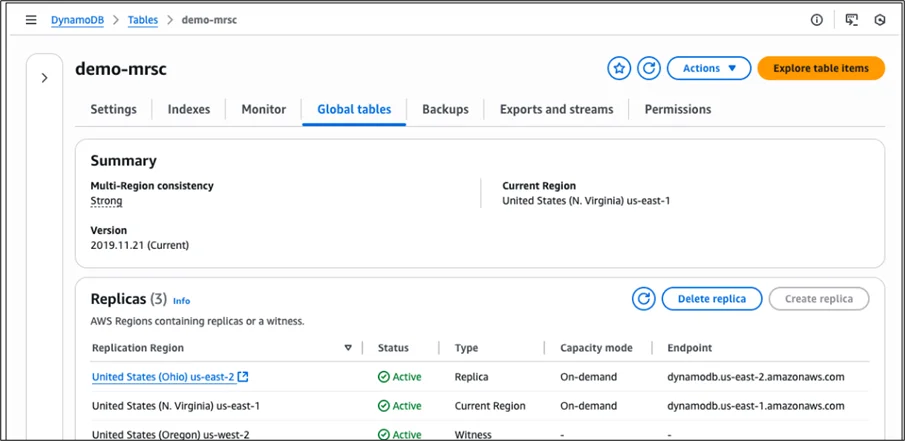|
Voiced by Amazon Polly |
Introduction
Modern applications demand high availability, resilience, and low latency, no matter where users are located. With growing global user bases, replicating data seamlessly across geographies becomes paramount. Amazon DynamoDB addresses this challenge with global tables, enabling multi-region, fully managed NoSQL databases that offer fast and reliable performance worldwide.
Until recently, global tables offered eventual consistency across regions. However, AWS has introduced multi-Region strong consistency, allowing you to build globally distributed apps with guaranteed read-after-write consistency across regions, a game changer for mission-critical workloads.

Pioneers in Cloud Consulting & Migration Services
- Reduced infrastructural costs
- Accelerated application deployment
Key Features
Here are the standout features of multi-region strong consistency in Amazon DynamoDB global tables:
- Strong Read Consistency Across Regions
Read operations in one region return the latest committed data written to any region.
- High Availability and Disaster Recovery
If one region fails, traffic automatically shifts to another region, ensuring zero downtime.
- Low Latency
Read/write operations are performed in the region closest to the user, reducing response time.
- Fully Managed
No manual replication, syncing, or conflict resolution, Amazon DynamoDB handles everything.
- Automatic Conflict Resolution
Writes are replicated across all regions in milliseconds with last-writer-wins reconciliation.
- Support for AWS SDKs and AWS IAM Policies
No changes to application code using AWS SDKs; works seamlessly with AWS Identity and Access Management (IAM).
Use Cases
- Global E-Commerce Platforms
Online retailers often operate in multiple countries. With global tables:
- Inventory updates in one region (e.g., a purchase in London) instantly reflect across other regions (e.g., warehouses in the US or Asia).
- Product availability, pricing, and discounts remain consistent for users worldwide.
- Cart and checkout systems are always up to date, ensuring zero loss of transaction data due to eventual consistency issues.
- Real-Time Multiplayer Gaming
Gaming applications demand ultra-low latency and real-time consistency:
- Player state (e.g., scores, health, achievements) is updated in real time across players globally.
- Leaderboards remain synchronized, ensuring fair competition.
- Chat, matchmaking, and live event systems stay consistent across global tournaments.
- Financial and Banking Systems
In finance, data consistency is non-negotiable:
- Transaction records are instantly synced across global banking servers.
- Account balances update in real time across apps, regardless of where the transaction originated.
- Strong consistency prevents issues like double-spending or incorrect balances.
- Collaborative SaaS Tools
Collaboration platforms (like document editing or project management tools) require consistent, synchronized user experiences:
- Document edits, comments, and annotations are updated in real time.
- Multi-region consistency ensures team members across continents always see the latest version.
- No risk of overwriting or conflicting updates.
- Healthcare Applications
Healthcare systems need accurate, up-to-date data across facilities:
- Patient records, lab results, and prescriptions are consistently accessible and editable globally.
- Ensures safe, timely treatments when patients move between hospitals in different regions.
- Strong consistency helps maintain regulatory compliance (HIPAA, GDPR).
- IoT Device Management
In an IoT ecosystem with devices across the globe:
- Device status, telemetry, and control commands are synced in real time across regions.
- Ensures consistent configuration and behavior regardless of physical location.
- Supports global industrial automation, smart cities, and connected vehicles.
Steps to Implement Multi-Region Strong Consistency
Here’s how to enable and implement multi-region strong consistency with Amazon DynamoDB global tables:
Step 1: Create a Global Table
- Navigate to the AWS Management Console → Amazon DynamoDB.
- Create a new table or select an existing one.
- Choose “Add Region” and select multiple regions for replication.

Step 2: Enable Strong Consistency
- When reading from the global table, use the ConsistentRead=True parameter in the AWS SDK.
- Strong consistency is achieved automatically if you read from the same region where the write occurred.
- Use Amazon DynamoDB Accelerator (DAX) for faster performance with consistent reads.

Step 3: Use AWS SDK for Region-Specific Operations
- Use the AWS_REGION environment variable or explicitly define the region in the SDK.
- Use retry logic and backoff strategies for network faults.

Step 4: Monitor and Audit
- Use Amazon CloudWatch to monitor replication lag and throughput.
- Enable AWS CloudTrail for auditing operations across all regions

Step 5: Test for Failover Scenarios
- Simulate regional failures and confirm automatic failover and data consistency.
Conclusion
Drop a query if you have any questions regarding Amazon DynamoDB and we will get back to you quickly.
Empowering organizations to become ‘data driven’ enterprises with our Cloud experts.
- Reduced infrastructure costs
- Timely data-driven decisions
About CloudThat
CloudThat is an award-winning company and the first in India to offer cloud training and consulting services worldwide. As a Microsoft Solutions Partner, AWS Advanced Tier Training Partner, and Google Cloud Platform Partner, CloudThat has empowered over 850,000 professionals through 600+ cloud certifications winning global recognition for its training excellence including 20 MCT Trainers in Microsoft’s Global Top 100 and an impressive 12 awards in the last 8 years. CloudThat specializes in Cloud Migration, Data Platforms, DevOps, IoT, and cutting-edge technologies like Gen AI & AI/ML. It has delivered over 500 consulting projects for 250+ organizations in 30+ countries as it continues to empower professionals and enterprises to thrive in the digital-first world.
FAQs
1. Is multi-region strong consistency available in all AWS Regions?
ANS: – As of 2024, multi-region strong consistency is supported in all commercial AWS regions that support Amazon DynamoDB global tables.
2. Is there an additional cost for enabling strong consistency?
ANS: – Strongly consistent reads cost more in terms of read capacity units (RCUs). There may also be additional inter-region data transfer costs.
3. Can I migrate my existing global tables to support strong consistency?
ANS: – Yes, you can update your application to use ConsistentRead=True in SDK calls. The table structure remains unchanged.

WRITTEN BY Neetika Gupta
Neetika Gupta works as a Subject Matter Expert at CloudThat with experience deploying multiple data science projects across various cloud platforms. She has successfully delivered end-to-end AI applications tailored to business requirements on cloud frameworks such as AWS, Azure, and GCP. Neetika also specializes in deploying scalable applications using CI/CD pipelines.


 Login
Login


 August 18, 2025
August 18, 2025 PREV
PREV









Comments